What is the effect of water quality on the flavor of caffeine?
Professional coffee knowledge exchange more coffee bean information please follow the coffee workshop (Wechat official account cafe_style)
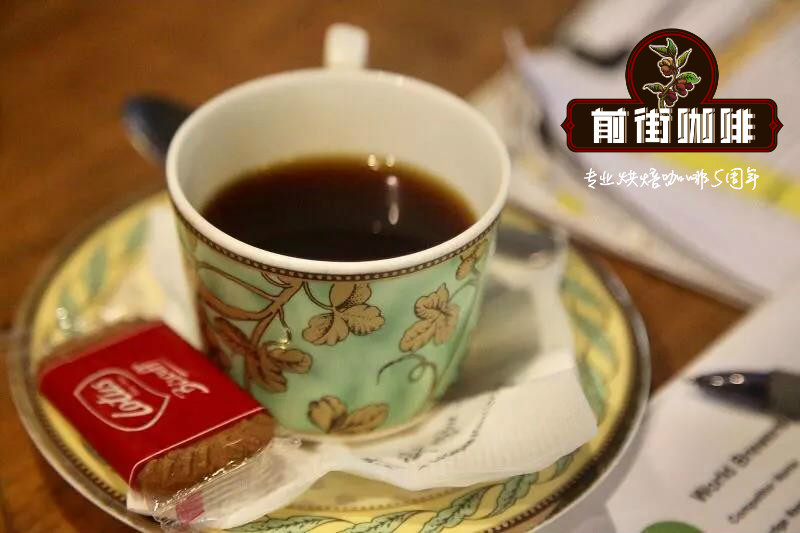
As we all know, more than 98% of a cup of coffee is water. the effect of water on the taste of coffee can be imagined. There are three main types of effects of water quality on coffee:
1 pH of water (PH value)
2 soluble substances in water (TDS)
(3) softness and hardness of water (content of calcium and magnesium ions in water)
Effect of water quality on the flavor of coffee
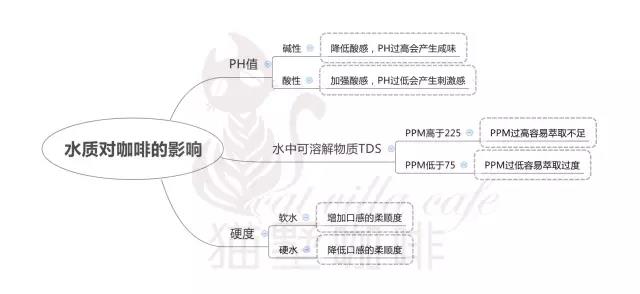
The pH of water (PH value)
Let's start with the pH (PH value) of water. Sometimes when we brew coffee, we will find that when we use different water to brew coffee, not only the taste of coffee will change, but also the color change of coffee can be clearly observed with the naked eye. This is because it is affected by the PH value of the water.
PH value refers to the strength values of acidity and basicity in aqueous solution. When the water is at 25 ℃, a PH value of 7 means neutral, a PH value greater than 7 indicates a stronger alkalinity, and a PH value less than 7 indicates a stronger acidity. The stronger the alkalinity is, the stronger the ability to counteract acid is; the stronger the acidity is, the stronger the ability to be counteracted by alkalinity is. However, tap water in China is generally weakly alkaline.
We should all know that coffee is a weakly acidic drink with a PH value of 5-6. If you use water with a PH value above 6 to brew coffee, it will increase the PH value and reduce the acidity of the coffee. The higher the PH value, the stronger the effect of reducing the sour taste. So sometimes when we use mineral water with higher PH value to brew coffee, at the same time, the sodium ion in the water is higher, it is easy to produce excessive salty taste.
Therefore, it is not that using water with higher PH value to brew coffee means that coffee tastes better. People who do not like strong sour taste will think that using water with higher PH value to brew coffee will make coffee taste softer, while people who are more receptive to sour taste will think that using water with higher PH value will easily make coffee lose its original flavor. So when we use mineral water to brew, we should remember to check the PH value on the label and the molecular content in mineral water as the basis for cooking. The choice of PH value of water is only a way to adjust the pH of coffee.
Soluble substances in water (TDS)
First of all, let's understand that TDS,TDS is the abbreviation of total dissolved solids in English. The unit of measurement is g / ton. It shows that 1 ton of water contains the gram weight of soluble solid matter, while 1 ton of water contains 1 g of soluble solid matter, that is, 1 part per million. The percentage of weight, abbreviated as ppm,ppm, is generally used as a unit of measurement of TDS.
To put it simply, the higher the ppm value, the more soluble matter in the water, so the lower the extraction rate of coffee will be; while the lower the ppm value, the less soluble matter in the water, so the higher the extraction rate of coffee.
According to the study of SCAA (American Fine Coffee Association), the ppm value of water is between 125and 175. it is the most ideal to extract coffee, and it is easy to reach an ideal value of concentration and extraction rate. However, when the ppm value is less than 75, it is more likely to be over-extracted, while when the ppm value is higher than 225, it is more likely to be underextracted.
Attach a sheet of the effect of different ppm values on gold cup extraction, the horizontal axis is the extraction rate, and the vertical axis is the coffee TDS concentration. We can clearly see the effect of different ppm values on the extraction rate of water and coffee.
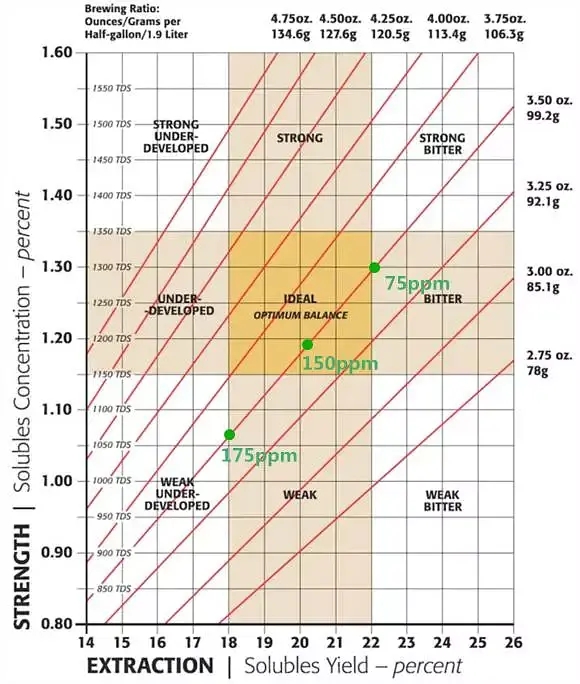
Because of the large latitude and longitude in China, the water quality of each city varies greatly, especially between the north and the south. The tap water in the north is often 300-500ppm, while the tap water in Xiamen, where Maoye is located, is generally between 60-80, so the same coffee bean may have different flavor if the same extraction method is used in different areas. Even-- the water quality of the same city will be different, mainly divided into old urban areas and new urban areas, the old urban areas use old iron pipes to transport water sources, and the aging of water pipes will increase the amount of iron oxide in the water. therefore, the water quality of the old city is generally not as clean as that of the new city, and it may cost more to use the water filter.
Attached are the standards for ppm values of drinking water in the United States, the European Union and China:
American drinking Water Standard: 0-50PPM
EU drinking Water Standard: 0-70PPM
Hygienic standards for drinking water for Chinese residents:
1. Tap water and daily drinking water should not exceed 300PPM
two。 Pure water below 50PPM
To test whether the quality of tap water, pure water and mineral water meets the drinking water standards formulated by the state:
Tap water below 300PPM
Pure water below 50PPM (national standard)
Mineral water 100-200PPM
The following may cause excessive consumption of brain cells. Read carefully.
--
Different water may have the same ppm value, but the composition of soluble solids may not be the same, so it will have some effect on flavor, and the problem may come back to the mineral itself. Because there are many metal cations and anions in the water, the common salty taste is mainly sodium ions, so you can try to use Kunlun Mountain mineral water and ordinary pure water. Kunlun Mountain mineral water has higher sodium ion content, so the salty taste is higher. According to the periodic table, alkaline ions similar to it can pass through ion channels and produce a salty taste, such as lithium or potassium ions, but the higher the cycle, the less salty and slightly bitter it is.
The common salty substances are NaCl, KCl, NaI, NaNO3, KNO3 and so on. In addition, if the alkaline-earth divalent cations of calcium ions pass through the ion channels that produce salty taste, they produce not salty, but bitter taste, among which magnesium ion produces the strongest bitter taste. In addition, it will have a sweet taste if it contains borax and copper sulfate. Since there are so many kinds of ions in the water, it is possible to bring out sour, sweet, bitter and salty tastes, it is obvious that the water with different TDS contents must be different in taste, so it is quite complicated.
The softness and hardness of water quality is basically determined by the content of calcium and magnesium ions in the water, which should belong to the category of TDS in theory, but because the ppm value is the same, but different soluble solid substances will also affect the softness and hardness of different water quality, Maoye separate the softness and hardness of water quality from the effect of TDS on coffee. For details, please see the softness and hardness of the water quality below.
Hardness and softness of water quality
Soft water (soft water) refers to water that contains no or less soluble calcium and magnesium compounds, while hard water is the opposite. The softened hard water refers to the softened water obtained when the content of calcium salt and magnesium salt is reduced to 1.0-50 mg / L. Although the hard water can be softened temporarily by boiling, boiling water is not used to extract coffee.
Soft water is a standard indicating the "hardness" of water quality, specifically the content of calcium and magnesium ions in a liter of water. In accordance with World Health Organization (WHO) standards:
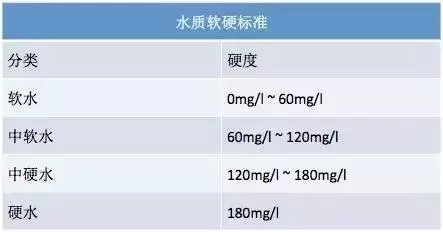
Generally speaking, the hardness of water is related to the ppm value of water. the content of calcium and magnesium ion is relatively high in water with high ppm value, and relatively low in water with low ppm value. However, when different water has the same ppm value, the composition of soluble solids in water may be different. In other words, the content of calcium and magnesium ions will be relatively different, at this time there will be the same ppm value of water, but the softness and hardness are different.
In daily life, we often see scale formation on the inner wall of the kettle after using for a long time, because the water we use contains a lot of inorganic salts, such as calcium and magnesium salts. These salts are invisible to the naked eye in water at room temperature. once they are heated and boiled, many calcium and magnesium salts precipitate in the form of carbonate, which form scale close to the pot wall. The water quality in Xiamen, where Maoye is located, is relatively soft, so the kettle or coffee machine is not prone to scale, but according to friends in the north, even if the new kettle is boiled with tap water a few times, it is possible to produce scale on the kettle wall. This should be a typical difference in water quality between the north and the south.
The content of calcium and magnesium in water is usually expressed by the index of "hardness". The hardness of 1 degree is equivalent to 10 mg of calcium oxide per liter of water. Water below 8 degrees is called soft water, water above 17 degrees is called hard water, and water between 8 and 17 degrees is called moderate hard water. Rain and snow water are soft water, while springs, deep wells, sea water, rivers and lakes all belong to hard water.
Of course, there are some water with high content of calcium and magnesium ions, but there is no scale formation, this is because these calcium and magnesium ions exist in the form of chloride, they are soluble, so they can not be precipitated when heated. Therefore, the absence of scale on the inner wall of the kettle does not mean that the water does not contain calcium and magnesium compounds, nor does it mean that its water quality belongs to soft water.
The effect of soft water and hard water on coffee is self-evident. Drinking soft water and hard water alone has a great difference in taste, not to mention the effect of water quality on the flavor of coffee. Soft water tastes softer, so the coffee brewed is also round and soft, but its sweetness is often not as high as that made by hard water. when there is an appropriate amount of calcium in the water, it will enhance the sweetness of coffee to a certain extent. however, if the calcium content is too high, the taste will not be soft and the touch will not be good. Not only in the difference between touch and sweetness, soft water will make the flavor of coffee less clear than hard water, because when extracting coffee, if there is a certain amount of calcium ions and carbides, the flavor can be cleverly balanced by these minerals. produced at the right amount of coffee powder, scale and temperature.
Therefore, not only soft water can produce a better taste, the corresponding soft and hard moderate water quality may be a better water for coffee extraction.
Important Notice :
前街咖啡 FrontStreet Coffee has moved to new addredd:
FrontStreet Coffee Address: 315,Donghua East Road,GuangZhou
Tel:020 38364473
- Prev
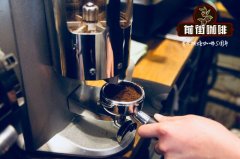
How to maintain and clean the coffee machine?
Professional coffee knowledge exchange more coffee bean information please follow the coffee workshop (Wechat official account cafe_style) We all know that "timely cleaning" is a good habit of baristas, whether it's going out to participate in competitions, roadshows, or activities in coffee clubs, cleaning the bar after making coffee can reflect the professional vegetarian of a barista or coffee practitioner.
- Next

The difference between hand-brewed Coffee and Italian Coffee can Italian coffee beans be brewed by hand
Professional coffee knowledge exchange more coffee bean information please follow the coffee workshop (Wechat official account cafe_style) coffee beans hand-brewed coffee: usually a single product of coffee beans as the raw material, roasting degree from light roasting, medium roasting to deep roasting are used. It is usually the degree of baking between the number of the figure below, about 9: 13. Espresso: a coffee shop has an Italian recipe called House Ble
Related
- What brand of black coffee is the most authentic and delicious? what are the characteristics of the flavor of the authentic Rose Summer Black Coffee?
- Introduction to the principle and characteristics of the correct use of mocha pot A detailed course of mocha pot brewing coffee is described in five steps.
- Which is better, decaf or regular coffee? how is decaf made?
- How much is a bag of four cat coffee?
- How about four Cat Coffee or Nestle Coffee? why is it a cheap scam?
- Which is better, Yunnan four Cats Coffee or Nestle Coffee? How about cat coffee? is it a fake scam? why is it so cheap?
- How about Cat Coffee? what grade is a hoax? which instant coffee tastes better, four Cat Coffee, Nestle Coffee or G7 coffee?
- Process flow chart of coffee making-Starbucks coffee making process what coffee tastes good at Starbucks
- The top ten best coffee beans in the world Rose summer coffee or Tanzanian coffee tastes good
- Yunnan four cat coffee is good to drink?_four cat coffee is a big brand? four cat blue mountain coffee is fake?

